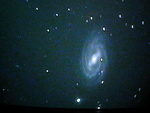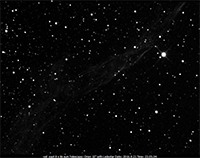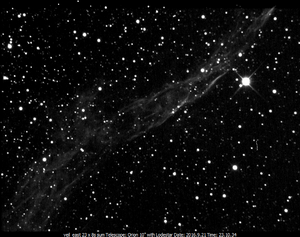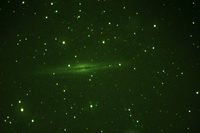Electronically Assisted Astronomy
Electronically Assisted Astronomy (EAA) is a new branch of the hobby focused on real-time (or nearly real-time) viewing of astronomical objects (usually deep sky) with an aid of electronic devices. Typically there are 3 choices: video cameras, live stacking and image intensifiers. I don't have much experience with image intensifiers, but I used to use video for observing and now I am engaged in live stacking techniques.
 Video astronomy is an easy way to EAA, with a moderate price tag, especially with the newest cameras. I used Mallincam with my Obsession 18 and got good results,
full description is here. I used a CRT
monitor, now one can use an equally good (or better) LCD, or just a
laptop. My problems with video astronomy are an artificial look
of the stars (black halos in hyper mode) and lots of noise. But with
video I could
see much deeper and a lot of more details than in an eyepiece, and I did not
need to collect data for hours (like for astrophotography) - it all
worked in minutes. Excellent articles about video astronomy by Rod Mollise can be found on his blog:
here and
here. The newer cameras are cheaper and also can be operated without
"hyper" sensitivity, therefore avoiding dreaded halos. The
field of view is still small..
Video astronomy is an easy way to EAA, with a moderate price tag, especially with the newest cameras. I used Mallincam with my Obsession 18 and got good results,
full description is here. I used a CRT
monitor, now one can use an equally good (or better) LCD, or just a
laptop. My problems with video astronomy are an artificial look
of the stars (black halos in hyper mode) and lots of noise. But with
video I could
see much deeper and a lot of more details than in an eyepiece, and I did not
need to collect data for hours (like for astrophotography) - it all
worked in minutes. Excellent articles about video astronomy by Rod Mollise can be found on his blog:
here and
here. The newer cameras are cheaper and also can be operated without
"hyper" sensitivity, therefore avoiding dreaded halos. The
field of view is still small..
 Live stacking is a common-sense approach: you take a sensitive CCD
camera that you already have for imaging (no need for more spending!),
set for short exposures and connect to a laptop for real-time
processing. The image is produced on the fly and improved with each new
frame coming from the camera. If set for summing, the image will brighten
with each new frame and the noise will diminish (see the animation on
the right). Gradually the faint
details will emerge ... Sounds easy? Well, it is! But only when you have
software capable of automatically registering incoming frames (including
shift and rotation) and also capable of basic stretching and light/dark
point operations. It is not easy to write such a software (as an active astrophotographer I can attest to how much time and effort processing takes!),
and it was the major bottleneck in this application. No more! There are
several programs available now:
Starlight Live
(free, but works only with Starlight Xpress cameras),
MiloSlick (works
with Mallincam - this way video can enter live stacking),
AstroToaster (uses
Deep Sky Stacker engine) and others.
Live stacking is a common-sense approach: you take a sensitive CCD
camera that you already have for imaging (no need for more spending!),
set for short exposures and connect to a laptop for real-time
processing. The image is produced on the fly and improved with each new
frame coming from the camera. If set for summing, the image will brighten
with each new frame and the noise will diminish (see the animation on
the right). Gradually the faint
details will emerge ... Sounds easy? Well, it is! But only when you have
software capable of automatically registering incoming frames (including
shift and rotation) and also capable of basic stretching and light/dark
point operations. It is not easy to write such a software (as an active astrophotographer I can attest to how much time and effort processing takes!),
and it was the major bottleneck in this application. No more! There are
several programs available now:
Starlight Live
(free, but works only with Starlight Xpress cameras),
MiloSlick (works
with Mallincam - this way video can enter live stacking),
AstroToaster (uses
Deep Sky Stacker engine) and others.
 Of course almost any CCD camera will do for live stacking, some even use
DSLRs, but very sensitive cameras will do best. In order for EAA to work
as observing tool it needs to be fast
and easy to setup (e.g. no guiding, short exposures) and fast to acquire
images (i.e.
short exposures, sensitive). Therefore choosing as sensitive camera as
possible is a good choice. I already have Starlight Xpress Lodestar
which I use for guiding, it is a very sensitive little camera and it
works with Starlight Live, so I grabbed it, downloaded the software
and gave it a go! Here is the page
with more details about my adventures with live stacking with more
info and pictures. IMHO at this time live stacking is the most
promising EAA approach, very natural, very customizable, and as close as
possible to observing/imaging. There is a good choice of various sensor
sizes, and best of all the cameras can be used for both EAA and "deep"
imaging. Very likely I will be buying a color camera (probably
Starlight Xpress Ultrastar Color) very soon ...
Of course almost any CCD camera will do for live stacking, some even use
DSLRs, but very sensitive cameras will do best. In order for EAA to work
as observing tool it needs to be fast
and easy to setup (e.g. no guiding, short exposures) and fast to acquire
images (i.e.
short exposures, sensitive). Therefore choosing as sensitive camera as
possible is a good choice. I already have Starlight Xpress Lodestar
which I use for guiding, it is a very sensitive little camera and it
works with Starlight Live, so I grabbed it, downloaded the software
and gave it a go! Here is the page
with more details about my adventures with live stacking with more
info and pictures. IMHO at this time live stacking is the most
promising EAA approach, very natural, very customizable, and as close as
possible to observing/imaging. There is a good choice of various sensor
sizes, and best of all the cameras can be used for both EAA and "deep"
imaging. Very likely I will be buying a color camera (probably
Starlight Xpress Ultrastar Color) very soon ...
BTW, Starlight Live was a software written to enjoy observing with Lodestar by Paul Shears in UK (and named Lodestar Live), then apparently taken up by Starlight Xpress and renamed. As I understand Paul still works with Starlight Xpress and continues to develop his software.
 Short word about image intensifiers. I was lucky to be able to play with
my friend Andrea's image intensifier at Black Forest Star Party 2016. It
can be dropped into a focuser as an eyepiece, or it can be attached
to a lens for wide field viewing. Andrea sent me a few pictures he made
at BFSP 2016, you can
see them here. The intensifier can be coupled with a filter (Ha or
OIII) to bring out the faintest of objects. We were able to see the
Horsehead nebula with it when all other means have failed ... The
picture looks artificial (green), and usually there is a lot of noise
(scintillation) in the view, but the picture is there! The biggest
problem here is the price - as I understand it starts at about $2,000.
Short word about image intensifiers. I was lucky to be able to play with
my friend Andrea's image intensifier at Black Forest Star Party 2016. It
can be dropped into a focuser as an eyepiece, or it can be attached
to a lens for wide field viewing. Andrea sent me a few pictures he made
at BFSP 2016, you can
see them here. The intensifier can be coupled with a filter (Ha or
OIII) to bring out the faintest of objects. We were able to see the
Horsehead nebula with it when all other means have failed ... The
picture looks artificial (green), and usually there is a lot of noise
(scintillation) in the view, but the picture is there! The biggest
problem here is the price - as I understand it starts at about $2,000.